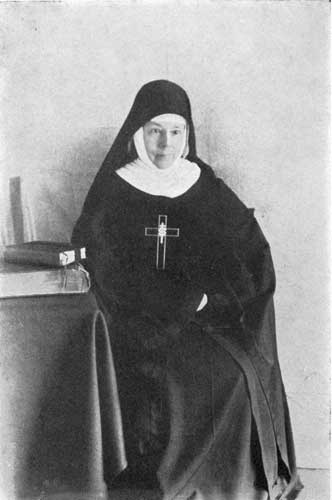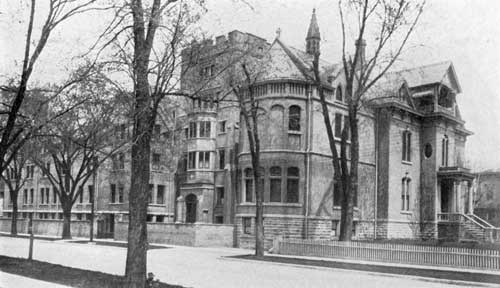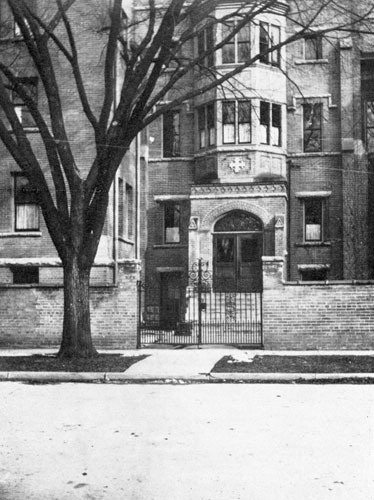Little by little, and none too rapidly, the Religious life is beginning to be valued, not because of its external work, but because of what it is in itself. Not through anything that Religious Orders have done in any of their manifold activities, but because of the simple consecration of the whole life to God, they are today in our Communion as in others, the great bulwark of the Catholic Faith, and we are not surprised to be told that there are more than four thousand Religious in the Anglican Communion and the number is daily increasing.
The Rule of the Sisterhood of the Holy Nativity, founded by Rev. Charles C. Grafton, afterwards Bishop of Fond du Lac, does not permit any kind of work in institutions. Nor are the Sisters to be a cloistered order, although the daily routine provides for much intercessory prayer in addition to the usual offices. It was the intention in the mind of the founder, faithfully carried out today, that the Sisters should give themselves to the aid of the parochial clergy in making known, the faith, teaching in Sunday Schools, preparing candidates for the Sacraments, and in every possible way helping to build up souls in the life of the Church.
In 1905, the Community moved to its new Convent in Fond du Lac, the See city of its Founder. Its work here has been chiefly in the Cathedral congregation, at St. Michael's Church, North Fond du Lac, and at Grafton Hall, a finely equipped school for girls whom the Sisters teach in Sunday classes, and assist in their preparation for the Sacraments, thus doing a valuable mission work, as many girls enter the school in ignorance of the Church, and go away loyal young missionaries, to make known in their widely scattered homes the Church's faith.
For over twenty years there have been two or three Sisters living on the Oneida Reservation, where the Community built a little house that they might minister to the Indians. They did much to assist the people materially by introducing, and at first directing, the lace industry. The Sisters have, of course, the care of the Altar and vestments in the well-appointed church, which was built in great measure by the Indians themselves and is the central point of interest to the tribe.
In the west, the Sisters are working at the Cathedral in [37/38] Milwaukee, and in the east at St. Mary the Virgin's, New York City; St. John's, Newport; Mt. Calvary, Baltimore; All Saints' Orange and St. Clement's, Philadelphia. They have also a Mission House in Providence, R. I., bought and supported chiefly by their Associates, and a House of Rest in Bay Shore, L. I., donated by a faithful Churchwoman for that purpose.
The literary work of the Sisterhood forms one branch of its missionary service. "Vocation", written by the Founder, and his other spiritual writings, have long appealed to earnest souls, and have revealed to some the call to the Religious Life. "Our Family Ways", "The New Creation", and "The Holy Warfare", by a member of the Community, are widely known; also a valuable and interesting address on "The Religious Life", given by one of the Sisters of the Society of the Companions of the Holy Cross at Adelynrood. "Self-consecration", a graceful translation of a French book of devotion by the Abbe Grou, was prepared by an Associate at the suggestion of the Community, and is dedicated to it. Other books and pamphlets are directly or indirectly included in the literary work of the Society.
At the Convent, the life of the Sisters is a round of constant, quiet activity and devotion. Some are engaged in fine needlework, for Altar linen, and ecclesiastical embroidery for Altar hangings or vestments, for which the demand has increased greatly, and which, in elaborate designs and costly materials, are made to order, while of plainer material and simpler embroidery, suitable vestments are made and sold at cost of material to poor parishes, or frequently given to such as cannot afford to purchase--thus carrying on a work begun at the especial wish of the founder, who desired a more general use of vestments for the purposes of impressing on the people the principles of the faith by means of outward tokens, and of helping them to a more reverent worship.
Other Sisters bake, cut and pack Altar breads of which 673,000 were sent out last year. Still others are engaged in filling the extensive orders received for the artistic devotional cards and pictures which are imported each year by thousands from England, France and Belgium. These cards, suitable for Christmas, Easter, birthdays and other occasions, are carefully selected, that they may be of real service and inspiration by their correct Church teaching and devotional and uplifting spirit.
By the wise counsel of the founders, well-chosen books of doctrinal and spiritual instruction have from the earliest days of the Community been the efficient helpers of the Sisters, both for their own needs and those of the many to whom they minister, and who are eager to learn "Church doctrine, Bible truth" and the way to grow in grace. A valuable aid in this work is a lending library, placed some years ago in the [38/39] charge of the Community, after the death of the zealous Churchwoman who founded and long conducted it, and in whose memory it is called "The Margaret Peabody Lending Library". Hundreds of books from this collection are sent out yearly (free of expense to the borrowers, except the return postage) to priests, teachers, theological students, and others who could not otherwise obtain the often expensive literature of this nature, and who live in remote parts of this country and even foreign lands. The expense of outward postage and of new books, which are purchased frequently as funds allow, is met by gifts from associates and others who have heard of the library and want to help on its missionary work.
Portions of each day are devoted to study, reading and recreation. The members of the novitiate pursue a definite and carefully planned course of study in the Bible, the Prayer-Book, in Church doctrine, etc., designed as a preparation for the teaching which is an especial work of the Community.
The Sisters' day begins, of course, with the Coming of the Lord to the Altar. The recitation of the Divine Office, which has been called "The voice of the Religious life", with its psalms, hymns, antiphons and prayers, marks the canonical hours. Throughout the day the work of intercession goes on, the Sisters relieving each other at the prayer-desk every half hour. They plead for the great needs of the Church and its missions, for the world with its trials, dangers and sins, and for individual souls in suffering, or in darkness and longing for light. Many petitions are sent in from far and near. And with the petitions rise joyful thanksgivings; for wonderful answers have come to the prayers whispered with devout faith into God's ear in the Chapel of the Blessed Sacrament. This work of intercession is carried on at the Mission Houses of the Community also.
The Community is entered by the usual steps of six months as postulant and two years as novice, with an additional two years during which the Sisters, now called junior professed, are under temporary vows, preliminary to the life vows at the expiration of this time.
Though both the revered founders have gone to their rest in God, their spirit still breathes in the life of the Community. For nearly thirty years, by precept and example, with wisdom and love, they watched over and guided it, and had the joy of seeing God give great increase in ever-widening fields of labour, in fruitful service, and in numbers of earnest women who have come from east and west, north and south, in response to the call to the Religious life in this Community, to which they have been led by some priest's suggestion, through acquaintance with some Sister, or by the printed words of "Vocation", through which the founder "being dead, yet speaketh."



